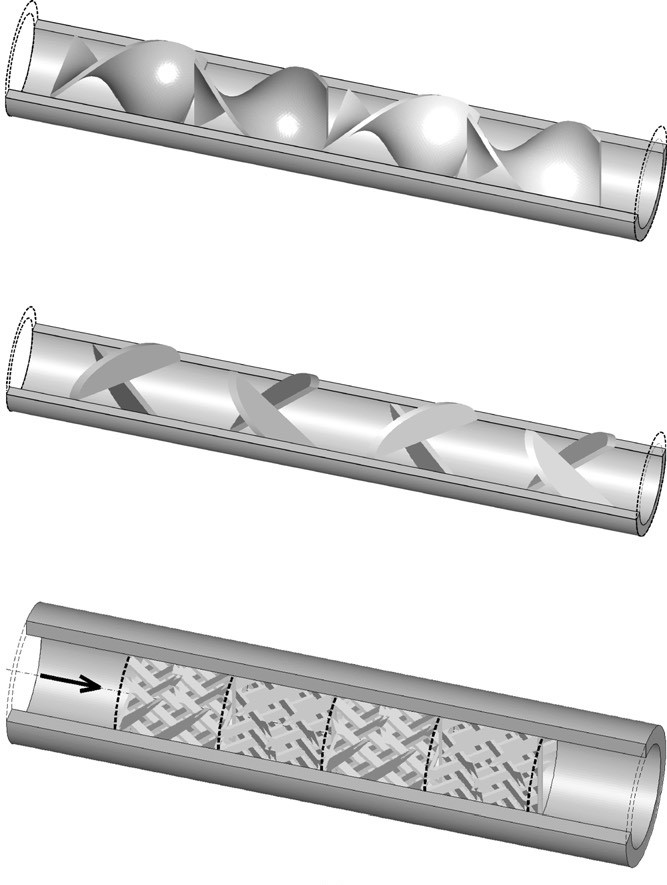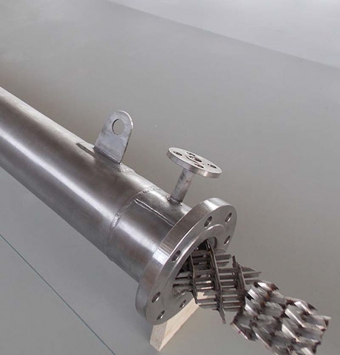Static Mixer
Hits : 6414 |
static mixers, also known as motionless mixers, have become standard equipment in the process industries. Static mixers are employed inline in a once-through process or in a recycle loop where they supplement or even replace a conventional agitator
?What is a Static Mixer
Static mixers, also known as motionless mixers, have become standard equipment in the process industries. Static mixers are employed inline in a once-through process or in a recycle loop where they supplement or even replace a conventional agitator.
Static mixers make a high degree of homogeneity in a very short length of pipe.Static mixer is a continuous radial mixing device, characterized by an effective degree of plug flow, depending on the specific design and application. It ranges in size from a few millimetres in diameter to units with equivalent diameters exceeding 3 m and volumes exceeding 100 m3.Their use in continuous processes is an attractive alternative to conventional agitation since similar and sometimes better performance can be achieved at lower cost.
Motionless mixers typically have lower energy consumptions and reduced maintenance requirements because they have no moving parts. They offer a more controlled and scalable rate of dilution in fed batch systems and can provide homogenization of feed streams with a minimum residence time. They are available in most materials of construction.

Design of Static Mixer
The prototypical design of a static mixer is a series of identical, motionless inserts that are called elements and that can be installed in pipes, columns or reactors. The purpose of the elements is to redistribute fluid in the directions transverse to the main flow, i.e. in the radial and tangential directions. The effectiveness of this redistribution is a function of the specific design and number of elements. Commercial static mixers have a wide variety of basic geometries and many adjustable parameters that can be optimized for specific applications. The number of elements in series is routinely adjusted. Another important parameter is the aspect ratio, defined as the ratio of length to diameter of a single element. Commercial designs typically use standard values for the various parameters that provide generally good performance throughout the range of applications and for which experimental data are available. Ordinarily, the use of standard designs is recommended. As a group, motionless mixers exhibit far higher efficiencies than rudimentary mixing devices such as elbows or tees and their performance is better characterized.
Applications of Static Mixer
Static mixer operations are essential in the process industries. They include the classical mixing of miscible fluids in single phase flow as well as heat transfer enhancement, dispersion of gas into a liquid continuous liquid phase, dispersion of an immiscible organic phase as drops in a continuous aqueous phase, three-phase contacting and mixing of solids. Static mixers have been applied to all these applications, including liquid–liquid systems (e.g. liquid–liquid extraction), gas–liquid systems (e.g. absorption), solid–liquid systems (e.g. pulp slurries) and solid–solid systems (e.g. solids blending).
Numerous static mixers are extensively used in various homogenization processes in industrial operations like polymer blending, chemical reactions, food processing, heat transfer, and in cosmetics and pharmaceutics, also in waste-water treatment. They are moreover frequently applied in disposable applications, like in in situ mixing of two-component, epoxy adhesives and sealants. The small space requirement, low equipment operation and maintenance costs, sharp residence time distribution, improved selectivity through intensified mixing and isothermal operation, byproduct reduction, and enhanced safety are the main features that have promoted the use of these devices

Advantages:
- Maintenance free
- Static Mixers are a low-cost alternative to traditional tank mixers both at purchase and during the mixer's lifetime. There are no running costs associated with operating a Static Mixer on top of running your existing pipeline.
- Because static mixers are motionless by design, all the energy required to provide a perfect blend is provided by the energy of the flow stream
- No moving parts hence extended product life
Limitations:
- Restriction and clogging may accrue
- Higher pressure loss
For learning more , we suggest you to read our Catalog here
Advantages
Applicable for both laminar and turbulent flow regime
compact and energy efficient
Low maintenance cost
No moving parts
No sealing problems
Simple Useful when limited space or access
Applications
and pharmaceuticals
food and beverages
Petrochemical and Chemical industry
plastics
power
Power plant
pulp and paper
Refineries
refining
You can download the datasheet here and send us your inquiry to Commercial@karajet.com


